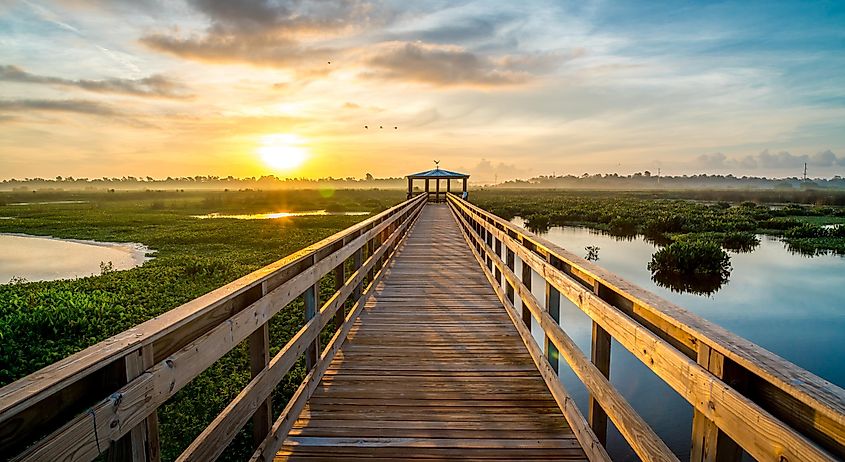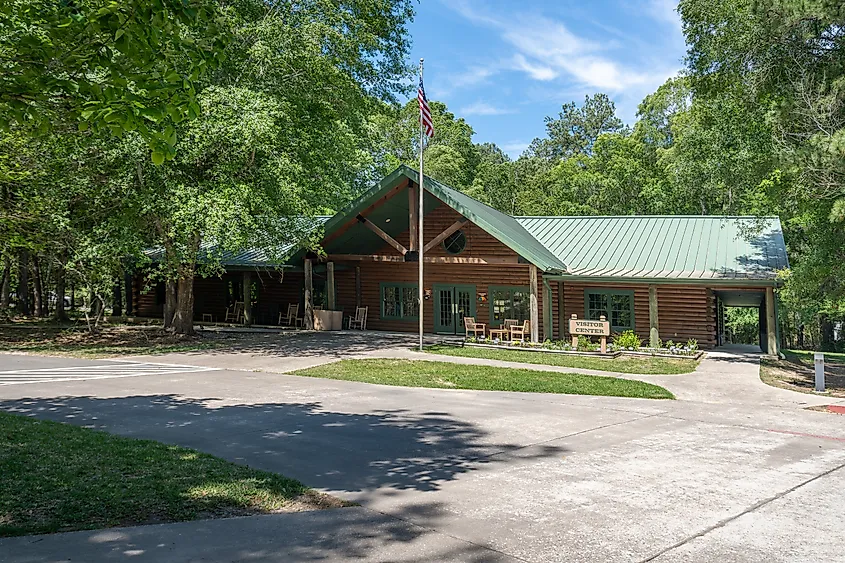
This Texas City Is An Underrated Gem For Nature Lovers
Tucked away in Southeast Texas, Beaumont might not be the first name that springs to mind for outdoor escapes, but this city holds a treasure trove of natural wonders waiting to be discovered. Nature lovers will be captivated by Beaumont’s natural treasures, from the sprawling 900-acre Cattail Marsh Wetlands teeming with birdlife and scenic boardwalks to the tranquil Beaumont Botanical Gardens with their vibrant array of native and exotic flora, while the Neches River offers adventurous kayaking and canoeing amid peaceful cypress-lined banks and abundant wildlife.
Indeed, Beaumont is a testament to the quiet allure of Southeast Texas, where nature takes center stage and every moment feels like an invitation to breathe and explore.
Why Beaumont Isn’t on Everyone’s Radar—Yet

Beaumont remains under the radar largely because it lacks the big-name attractions or heavily marketed appeal of Texas’s larger cities. While places like Austin and Houston thrive on their nightlife, cultural festivals, and iconic landmarks, Beaumont quietly offers a more subdued experience rooted in nature and local charm. This lack of commercialization, though a draw for those seeking tranquility, means the city doesn’t receive the same level of attention in travel guides or tourism campaigns. Many travelers simply don’t think to look beyond Texas’s better-known destinations, leaving Beaumont’s natural treasures largely undiscovered.
Another reason for its underrated status is its geographic location. Situated in Southeast Texas, Beaumont is often viewed as a waypoint between Houston and Louisiana rather than a destination in its own right. Visitors traveling along Interstate 10 may not realize that just minutes from the highway lies a haven of wetlands, forests, and rivers waiting to be explored.
What Makes Beaumont Truly Unique

Jefferson County Courthouse at Sunrise - Beaumont East Texas.
Beaumont’s uniqueness lies in its role as a crossroads of diverse natural ecosystems, cultural influences, and history that converge in unexpected ways. Unlike many other nature-focused destinations, Beaumont sits at the meeting point of multiple ecological zones. This intersection allows visitors to experience pine forests, wetlands, prairies, and riverine environments, all within a short distance. The Big Thicket National Preserve is often called the “Biological Crossroads of North America.” It is a testament to this diversity, housing an unparalleled variety of plants and animals that thrive in overlapping habitats found nowhere else in the country.
Adding to its distinctiveness, Beaumont’s natural spaces are intertwined with its cultural heritage. The city’s Spindletop-Gladys City Boomtown Museum is a glimpse into the oil industry’s beginnings, and it sits just minutes away from sprawling natural areas like Tyrrell Park. This juxtaposition of history and nature creates a layered experience for visitors, where they can paddle the Neches River in the morning and explore Beaumont’s cultural roots in the afternoon. Beaumont also embraces its identity through eco-tourism initiatives that highlight not just its natural beauty but also the importance of preserving these unique environments for future generations. This harmony of diverse ecosystems, culture, and conservation makes Beaumont a truly one-of-a-kind destination.
Exploring Beaumont’s Natural Treasures

Beaumont has a variety of parks and green spaces. Tyrrell Park, one of the city’s largest recreational areas, is home to the Beaumont Botanical Gardens. These gardens showcase meticulously landscaped paths lined with vibrant blooms, a butterfly habitat, and the Warren Loose Conservatory—the largest conservatory in Southeast Texas. Nearby, the 900-acre Cattail Marsh Wetlands, also within Tyrrell Park, has a combination of ponds, marshes, and walking trails. Visitors can stroll along the boardwalks or relax at the viewing platforms, surrounded by the sounds of rustling reeds and the calls of native Texas birds.
For hiking and walking enthusiasts, the Big Thicket National Preserve, located just a short drive north of the city, features over 40 miles of trails through ecosystems ranging from pine forests to hardwood swamps. The Kirby Nature Trail is a favorite, with its boardwalks crossing over streams and shaded paths teeming with Texas wildlife. Alternatively, the Gulf Terrace Hike and Bike Trail have paved routes ideal for runners and cyclists, with views of open meadows and native trees.
The Neches River is the lifeblood of Beaumont’s outdoor adventures. Kayaking and canoeing are particularly popular, with calm waters winding through cypress-lined banks and hidden backwaters where wildlife thrives. Rentals and guided tours are available for those eager to explore the river’s scenic routes. Each step or stroke reveals the city’s intimate connection with its surroundings, making Beaumont a natural playground.
Birdwatching and Wildlife Encounters

Beaumont is a paradise for wildlife enthusiasts, particularly birdwatchers, thanks to its location along the Central Flyway migratory path. Over 250 species have been recorded at the Cattail Marsh Wetlands, including roseate spoonbills, great egrets, and snowy plovers. Big Thicket National Preserve is another hotspot for spotting wildlife, from river otters to whitetail deer. If you're lucky, you might even spot bobcats or feral hogs. Seasonal eco-tours on the Neches River offer close encounters with aquatic species like garfish and bullfrogs, as well as a chance to see herons and osprey hunting along the banks.
A Community Dedicated to Nature

Beaumont's compact layout ensures that major attractions like Tyrrell Park and Cattail Marsh Wetlands are just a short drive from the heart of downtown. For cyclists, well-maintained bike paths such as the Gulf Terrace Hike and Bike Trail connect urban areas to scenic green spaces, encouraging eco-friendly travel.
Beaumont’s residents take pride in preserving the area’s natural beauty, and this dedication is evident in community-led initiatives like the Beaumont Botanical Gardens, which are maintained by local volunteers and donations. Additionally, Neighborhood Cleanup and Adopt-a-Street programs promote sustainability by organizing clean-up events and advocating for environmentally responsible practices. Beaumont’s commitment to environmental stewardship and accessibility ensures that its natural and urban environments remain in harmony.
Practical Tips for a Memorable Visit

To make the most of your visit to Beaumont, timing is everything. The best seasons to experience its natural beauty are spring and fall when the weather is mild, and the landscapes burst with color. Spring brings vibrant blooms to the Beaumont Botanical Gardens and an influx of migratory birds at Cattail Marsh Wetlands, while fall offers cooler temperatures ideal for hiking the Big Thicket National Preserve. Texas summers can be hot and humid, so if you visit during this time, plan early morning or evening activities to avoid the heat.
Getting around Beaumont is straightforward, as most attractions are within a 15-minute drive from downtown. Renting a car is the most convenient option for exploring the city and nearby natural areas like the Neches River or Big Thicket. For those who prefer eco-friendly transportation, Beaumont offers bike-friendly trails and walkable neighborhoods, especially near Tyrrell Park. Don’t miss local events like the Beaumont Birdies birding tours or seasonal eco-tours along the Neches River, which provide unique insights into the region’s wildlife and ecosystems. Lastly, pack sturdy shoes for hiking and binoculars for birdwatching—these essentials will enhance your adventure.
Beaumont: A Quiet Gem Worth Discovering
Beaumont, nestled in Southeast Texas, is a quiet haven of natural beauty and authentic charm. From the bird-filled Cattail Marsh Wetlands to the lush Beaumont Botanical Gardens and the winding Neches River, it offers escapes for nature lovers. Its unique blend of diverse ecosystems and rich history, paired with a commitment to conservation, sets it apart from crowded Texas destinations. In Beaumont, every experience—whether hiking, kayaking or simply unwinding—feels like a rare chance to reconnect with the outdoors.











